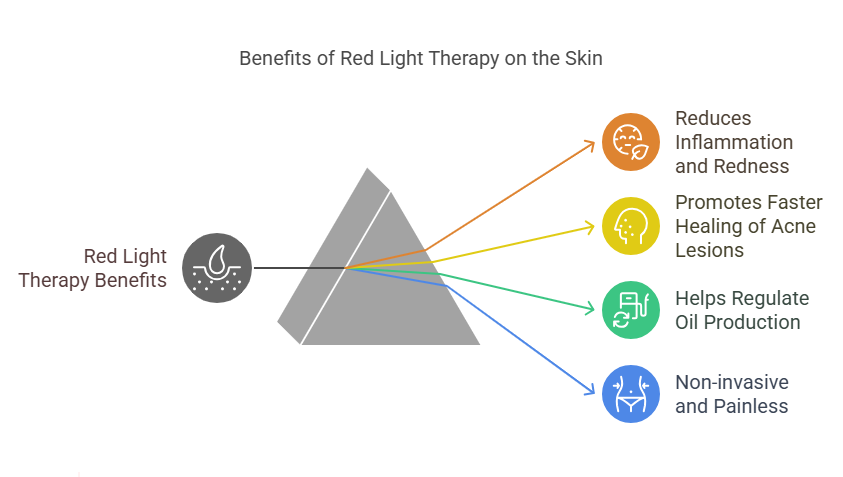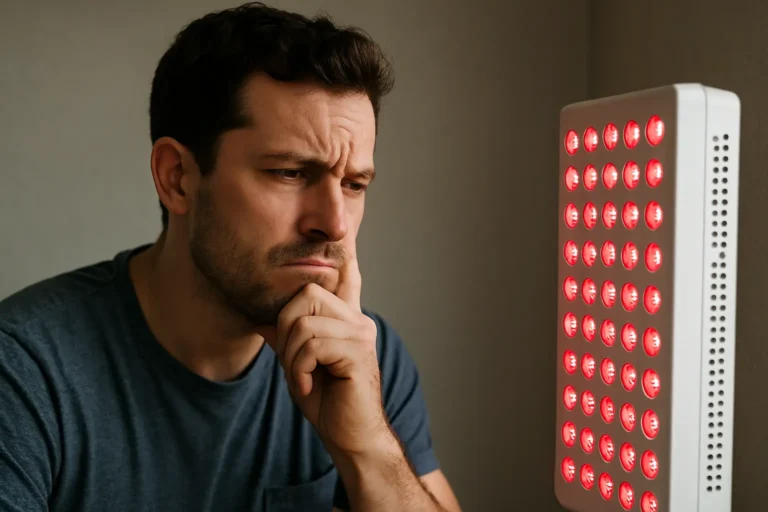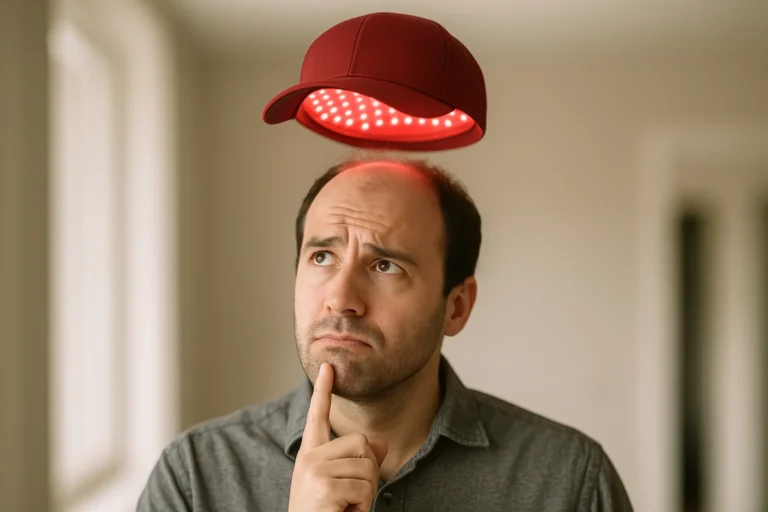Acne can be frustrating, painful, and downright stubborn. Trust me, I’ve been there standing in front of the mirror, trying every cream, serum, and DIY remedy under the sun, only to feel like my skin was fighting back harder. But what if there was a non-invasive, science-backed solution that could actually help? Enter red light therapy!

This innovative treatment has been making waves in the skincare world, and for good reason. It promises to reduce inflammation, kill acne-causing bacteria, and promote clearer, healthier skin—all without the harsh side effects of some traditional treatments. Sounds too good to be true, right? That’s exactly what I thought when I first heard about it. But after diving into the research and trying it myself, I realized there’s more to this glowing trend than meets the eye.
In this article, we’ll break down the science behind red light therapy, explore its benefits for the skin, and help you figure out if it’s the right fit for your skincare routine. Whether you’re dealing with stubborn breakouts or just curious about this buzzworthy treatment, you’re in the right place. Let’s get glowing!
What Is Red Light Therapy and How Does It Work?
Red light therapy might sound like something out of a sci-fi movie, but it’s actually a well-researched treatment with roots in medical and cosmetic science. Originally developed by NASA to help astronauts heal wounds in space (yes, really!), it’s now being used to treat everything from wrinkles to chronic pain—and, of course, acne.
So, how does it work? Red light therapy uses low-level wavelengths of light to penetrate the skin. Unlike UV rays, which can damage your skin, red light is completely safe and works at a cellular level. It stimulates your skin cells to produce more energy (in the form of ATP), which helps them repair damage faster. For acne, this means reducing inflammation, calming redness, and even killing the bacteria that cause breakouts.

Here’s the cool part: red light therapy doesn’t just treat the surface of your skin. It goes deeper, targeting the sebaceous glands (those little oil factories in your skin) to help regulate oil production. Less oil means fewer clogged pores, which means fewer breakouts. It’s like giving your skin a reset button!
The Benefits of Red Light Therapy for Acne
When I first started using red light therapy, I wasn’t expecting miracles. But after a few weeks, I noticed some real changes, less redness, fewer painful breakouts, and an overall healthier glow. Here’s why it works so well:

- Reduces inflammation and redness: If you’ve ever had a breakout that made your skin look angry and irritated, you’ll love this benefit. Red light therapy calms your skin down, reducing the redness and swelling that make acne so noticeable.
- Promotes faster healing of acne lesions: You know those spots that seem to linger forever? Red light therapy helps speed up the healing process by boosting your skin’s natural repair mechanisms.
- Helps regulate oil production: Overactive oil glands are a major culprit behind acne. By targeting these glands, red light therapy helps keep oil production in check, which can prevent future breakouts.
- Non-invasive and painless: Unlike some treatments that leave your skin feeling raw or irritated, red light therapy is completely painless. It’s like lying under a warm, soothing light—no needles, no chemicals, no downtime.
Honestly, the best part is how easy it is to incorporate into your routine. Whether you go for professional treatments or invest in an at-home device, it’s a simple, low-maintenance way to give your skin some extra love. And while it’s not a magic cure-all, it’s definitely a game-changer for anyone looking to tackle acne in a gentle, effective way.
Is Red Light Therapy Effective for All Types of Acne?
When it comes to acne, not all breakouts are created equal. Red light therapy can be a fantastic option for mild to moderate acne, but it’s not a one-size-fits-all solution. If you’re dealing with the occasional breakout or persistent but manageable acne, red light therapy can work wonders. It reduces inflammation, calms redness, and helps prevent new pimples from forming by targeting oil production and acne-causing bacteria.
However, for severe or cystic acne, the results can be a bit more hit-or-miss. Cystic acne is often rooted deeper in the skin and influenced by hormonal imbalances, which red light therapy can’t fully address. I’ve had friends with cystic acne who saw some improvement in redness and swelling, but they still needed additional treatments like prescription medications or hormonal therapy to tackle the root cause.
That said, combining red light therapy with other treatments can be a game-changer. For example, pairing it with blue light therapy (which specifically targets acne-causing bacteria) or using it alongside topical treatments like benzoyl peroxide or salicylic acid can amplify the results. Just be sure to consult with a dermatologist before mixing treatments to avoid overloading your skin. Think of red light therapy as a powerful tool in your acne-fighting arsenal—it’s not the whole solution, but it can definitely help tip the scales in your favor.
How to Use Red Light Therapy for Acne Treatment
Using red light therapy is surprisingly simple, but there are a few things you need to know to get the best results. First, let’s talk about the two main options: at-home devices and professional treatments.
- At-home devices: These are super convenient and cost-effective in the long run. You can find handheld devices, face masks, or even full panels designed for home use. They’re great for consistency since you can use them whenever it fits your schedule.
- Professional treatments: If you want a more powerful option, professional treatments at a dermatologist’s office or spa might be worth considering. These devices are stronger than at-home versions, so you may see results faster, but they can be pricey.

Now, let’s break down how to use red light therapy safely:
- Clean your skin: Start with a clean face to remove any makeup, dirt, or oil. This ensures the light can penetrate your skin effectively.
- Position the device: If you’re using an at-home device, follow the manufacturer’s instructions. Most devices should be held a few inches from your skin or worn as a mask.
- Set the timer: Sessions typically last 10-20 minutes. Don’t overdo it—more time doesn’t mean better results!
- Be consistent: Use the therapy 3-5 times a week for the first few weeks, then adjust based on your skin’s response.
It’s important to be patient. Red light therapy isn’t an overnight fix, You don’t need to have treatments everyday, but with consistent use, you’ll start to notice improvements in your skin’s texture, tone, and overall clarity.
Potential Side Effects and Risks of Red Light Therapy
One of the reasons red light therapy is so popular is because it’s generally safe and well-tolerated. That said, no treatment is completely risk-free, so it’s important to know what to expect.
The most common side effects are mild and temporary. You might notice some redness or dryness after a session, especially if you’re new to the treatment. I remember my first week using a red light mask—I thought my skin felt a little tight, but it went away after I adjusted the session length. If you experience any discomfort, try reducing the duration or frequency of your sessions.
That said, red light therapy isn’t for everyone. If you have a medical condition like lupus or are taking medications that make your skin sensitive to light, it’s best to avoid this treatment. Pregnant women should also consult their doctor before starting red light therapy, just to be safe.
To minimize risks, always follow the instructions for your device and avoid staring directly into the light (even if it’s labeled as safe for eyes). If you’re using an at-home device, make sure it’s FDA-approved or recommended by a dermatologist. And remember, more isn’t always better—stick to the recommended session times to avoid overexposure.

With a little care and attention, red light therapy can be a safe and effective addition to your skincare routine. Just listen to your skin and adjust as needed—it’ll thank you for it!
Red Light Therapy vs. Other Acne Treatments: How Does It Compare?
When it comes to acne treatments, there’s no shortage of options. From blue light therapy to topical creams and oral medications, each approach has its strengths and weaknesses. So, how does red light therapy stack up?

Let’s start with blue light therapy. While red light therapy focuses on reducing inflammation and promoting healing, blue light therapy is all about targeting acne-causing bacteria. It’s great for active breakouts, especially if you’re dealing with whiteheads or pustules. However, blue light doesn’t address the underlying inflammation or help with skin repair the way red light does. Many people find that combining the two therapies gives the best results—kind of like a one-two punch for acne.
Now, compare red light therapy to topical treatments like benzoyl peroxide or salicylic acid. These are often the first line of defense for acne, and they can be very effective. But let’s be real, topicals can be harsh. I’ve had my fair share of peeling, stinging, and redness from overusing acne creams. Red light therapy, on the other hand, is gentle and non-invasive. It’s a great option if your skin is sensitive or if you’re tired of dealing with the side effects of harsh chemicals.
As for oral medications like antibiotics or isotretinoin (Accutane), these are typically reserved for more severe cases of acne. They can be life-changing, but they also come with significant risks and side effects. Red light therapy doesn’t replace these treatments, but it can be a helpful addition, especially for managing inflammation and promoting skin healing during or after a course of medication.
In terms of cost-effectiveness, red light therapy can be a bit of an investment upfront, especially if you’re buying an at-home device. But when you consider the long-term benefits—fewer breakouts, less redness, and improved skin health, it’s often worth it. Plus, once you have a device, you can use it for years without ongoing costs, unlike prescription medications or regular dermatologist visits.
Choosing the Right Red Light Therapy Device for Acne
If you’re ready to give red light therapy a try, the first step is choosing the right device. With so many options on the market, it can feel overwhelming, but here’s what to look for:
- Wavelength: The most effective red light therapy devices for acne use wavelengths between 600-650 nanometers. This range penetrates the skin deeply enough to reduce inflammation and promote healing.
- Power output: Look for a device with a high enough power output to deliver effective results without requiring long sessions. Most at-home devices will specify their power in milliwatts per square centimeter (mW/cm²).
- Ease of use: Whether it’s a handheld device, a face mask, or a panel, choose something that fits your lifestyle. If you’re short on time, a mask you can wear while multitasking might be your best bet.
Some of the top-rated at-home devices for 2025 include the CurrentBody Skin LED Light Therapy Mask, the Mito Red Light Min, and the LightStim for Acne. These devices are highly rated for their effectiveness, ease of use, and durability.
If you’re not ready to commit to an at-home device, consider professional treatments. Dermatologists and med spas often use more powerful devices that can deliver faster results. This is a great option if you’re dealing with a big event (like a wedding!) and want to see improvements quickly. Just keep in mind that professional treatments can be pricey, so they’re not always the most cost-effective option for long-term use.
Real-Life Results: Does Red Light Therapy Really Work?
So, does red light therapy actually deliver on its promises? Based on both research and real-life experiences, the answer is a resounding yes, but with a few caveats.
I remember being skeptical when I first started using red light therapy. My skin wasn’t in terrible shape, but I had persistent redness and those annoying little breakouts that never seemed to go away. After about four weeks of consistent use, I noticed a real difference. My skin looked calmer, my breakouts healed faster, and I even got a few compliments on my “glow.”
And I’m not alone. Many users report similar results, especially when they stick to a regular routine. One friend of mine swears by her red light mask, she says it’s the only thing that’s ever helped with her hormonal acne. Of course, results can vary depending on factors like your skin type, the severity of your acne, and how consistent you are with treatments.

The science backs this up, too. Clinical studies have shown that red light therapy can significantly reduce acne lesions and improve skin texture over time. For example, a 2017 study found that participants who used red light therapy twice a week for 12 weeks saw a 50% reduction in acne lesions. That’s pretty impressive!
That said, it’s not a miracle cure. If you’re expecting overnight results, you might be disappointed. Red light therapy works best as part of a comprehensive skincare routine, and it takes time to see the full benefits. But if you’re patient and consistent, it can be a game-changer for your skin.
Conclusion
Red light therapy is a promising, non-invasive treatment for acne that’s backed by science and loved by many. It’s not just another skincare trend—it’s a well-researched option that can help reduce inflammation, speed up healing, and improve your skin’s overall health. Whether you’re dealing with mild breakouts or looking for a way to calm redness and irritation, red light therapy offers a gentle, effective solution that fits into almost any skincare routine.
That said, it’s important to keep your expectations realistic. While red light therapy can deliver noticeable improvements, it’s not a magic wand that will make acne disappear overnight. Consistency is key, and combining it with other treatments or a solid skincare routine can help you get the best results. Think of it as a long-term investment in your skin’s health rather than a quick fix.
If you’re tired of battling breakouts and feeling like nothing works, red light therapy might just be worth a try. With so many at-home devices and professional options available, it’s easier than ever to find a solution that fits your needs and budget. So why not take the leap? Explore your options, do your research, and start your journey to clearer, healthier skin today. Your future self will thank you!
FAQ: Red Light Therapy for Acne
What is red light therapy, and how does it work for acne?
Red light therapy uses low-level wavelengths of light (typically between 600-650 nanometers) to penetrate the skin and stimulate cellular repair. It reduces inflammation, calms redness, and promotes healing by increasing energy production in skin cells. For acne, it also helps regulate oil production and targets acne-causing bacteria, making it an effective treatment for mild to moderate breakouts.
What are the main benefits of red light therapy for acne?
Red light therapy offers several benefits for acne-prone skin, including:
Reducing inflammation and redness.
Speeding up the healing of acne lesions.
Regulating oil production to prevent future breakouts.
Providing a non-invasive, painless treatment option with no downtime.
Is red light therapy effective for all types of acne?
Red light therapy works best for mild to moderate acne, where it can reduce inflammation and promote healing. However, it may not be as effective for severe or cystic acne, which often requires additional treatments like oral medications or hormonal therapy. Combining red light therapy with other treatments, such as blue light therapy or topical solutions, can enhance its effectiveness.
How do I use red light therapy for acne treatment?
To use red light therapy:
Start with clean, dry skin.
Position the device a few inches from your face or wear it as a mask, depending on the type of device.
Use the therapy for 10-20 minutes per session, 3-5 times a week.
Be consistent and patient, as results typically appear after several weeks of regular use.
Are there any side effects or risks of red light therapy?
Red light therapy is generally safe and well-tolerated, but some users may experience mild side effects like temporary redness or dryness. It’s not recommended for people with light-sensitive conditions, those taking photosensitizing medications, or pregnant individuals without consulting a doctor. To minimize risks, follow the device’s instructions and avoid overuse.
How does red light therapy compare to other acne treatments?
Compared to other treatments:
Blue light therapy targets acne-causing bacteria, while red light focuses on reducing inflammation and healing.
Topical treatments like salicylic acid or benzoyl peroxide can be harsher on the skin, while red light therapy is gentle and non-invasive.
Oral medications are effective for severe acne but come with significant side effects, whereas red light therapy is safer for long-term use.
How do I choose the right red light therapy device for acne?
When selecting a device, look for:
Wavelengths in the 600-650 nanometer range for effective acne treatment.
Power output that ensures efficient results without requiring long sessions.
Ease of use, such as wearable masks or handheld devices that fit your lifestyle.




